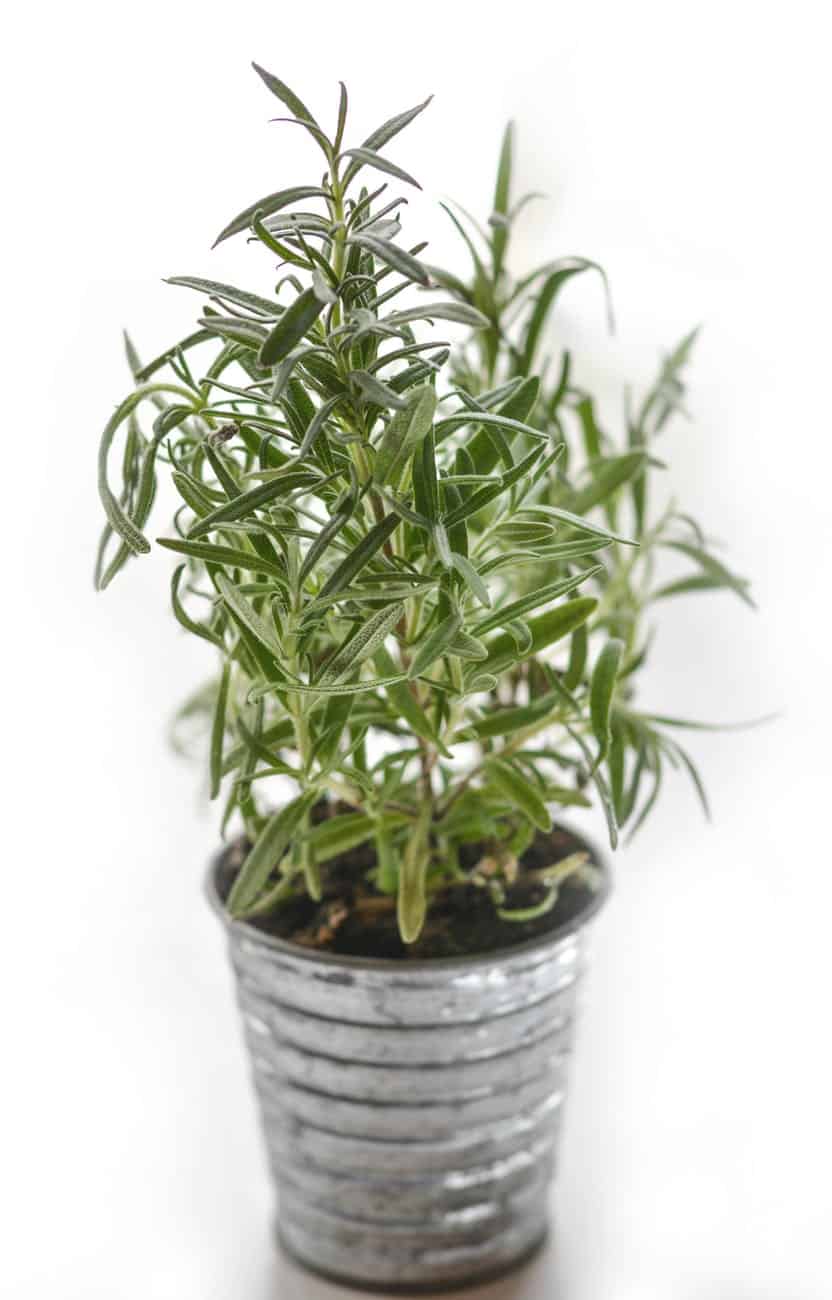Contents
There’s nothing quite like cooking with veggies and herbs that are fresh from your garden; rosemaries are no exception. Rosemary is useful for cooking as the main ingredient or by serving as a garnish. With its diverse uses, you shouldn’t have to buy one from the grocery store each time you want to use it. It’s one commonly grown herb that anyone could grow in their home using either a garden or several pots as it’s a straightforward process to follow. Therefore, if you’re looking to grow a herb garden of your own, you should keep reading but first, let’s cover the basics.

Rosemary Basics
It’s a Herb: The rosemary plant is an aromatic plant native to the Mediterranean climate. The herbaceous plant has aromatic leaves that are commonly used for culinary and medicinal purposes.
Method of Propagation: Asexual propagation methods such as stem cuttings from the parent plant are the most common method for growing Rosemary. The other method is to grow the plants from seed.
Planting Season: The wonderful herb favors the summer, but it’s best planted during the late spring season.
Planting Soil: The best options for planting Rosemary include any sandy soil mix, damp potting soil mix, and the best, well-drained loamy Soil. These soil types have the essential nutrients needed for their growth and prevent root rot from developing in the plant.
Exposure to Sunlight: The perennial herb is best planted in a sunny location with total exposure to sunlight.
How do you Grow Rosemary?
Depending on where you’re located, you can grow Rosemary in pots or the ground. For cooler climates or places with little to no garden space, planting larger containers indoors is recommended. In contrast, those in a warm location can plant it in the ground as the weather will be favorable for the Rosemary all year round.
For those in colder climates, pots are the best option as they allow you to move the Rosemary away from the cold during the winter. There are several ways to grow a rosemary plant, depending on the means available to you. However, the most commonly used methods of propagating Rosemary are from seeds and cuttings.
Propagating Rosemary from seed is the less used option as it has lower chances of success. It is possible to plant seeds and yield no results despite doing everything right. Propagating from cuttings obtained from the mother plant is the most used option for indirect light growing Rosemary.

Good to Read: Growing & Propagating Basil From Cuttings – Here’s How?
Propagating Rosemary from Stem Cuttings
It may be the best option available, but that doesn’t mean it is the fastest. When done correctly, it can still take as long as a couple of months to a year before you have a mature rosemary plant that you can harvest from. To grow Rosemary from cuttings, you’ll have to do the following:
Getting some Rosemary Cuttings
You can’t grow Rosemary from cuttings unless you have some rosemary cuttings. If you know anyone who has Rosemary in their home, you can get the cuttings from them. If you happen to be one of those who already have a previous plant at home, you can obtain cuttings from it using a sharp knife. If you don’t have access to Rosemary in your home, you can get some at local stores. Of course, it is preferable to get the Rosemary from a tree yourself, but the store quality is alright as well.
Trim the Bottom of the Cutting
After obtaining the rosemary stem cuttings, remove any leaves located at the base of the stem. We need to make sure at least 2 inches of the base of the stem is devoid of leaves. This base will become the new roots when the rosemary cutting is planted. To transplant, cut the tip at 45⁰, allowing direct exposure to the center of the rosemary cutting. Should you wish to plant later, you can store the cutting till you need it. Then, wrap it in a plastic bag and store it in your refrigerator.
Dip the Cutting in Root Growth Hormone
This step isn’t compulsory, but it can help establish a root system quickly and more effectively. A solid root system will be established with or without a growth hormone but will take longer. Since you plan to eat this Rosemary at some point, it may not be advisable to use a growth hormone or risk altering the rosemary output. If you’re using the growth hormone, dip the Rosemary in a jar of water first, then in the growth hormone. In the absence of a growth hormone, dip it in fresh water, and you’re set to plant.
Start the Root Structure
Depending on whether or not you use a growth hormone, the root structure has two paths. If you use a growth hormone, then you can plant it in the Soil immediately. However, for those planting in pots, you will need to make sure the Soil is well-drained. To ensure that the Soil is well-drained, use a pot having drainage holes.
At this point, you can plant the cuttings in small pots, allowing you to move them around quickly, and transplant them to a bigger pot after the root is established. But, again, let the root be established before planting for those who choose to proceed without using a growth hormone.
Place the lower two inches (devoid of leaves) in a glass of water. Let it remain there for about 3-4 weeks, by which time you should notice roots sprouting out. Next, move the plant to your already prepped Soil, ensuring good contact so that the growth can continue immediately.
Observe for Growth
The weather will determine how long it will take for your rosemary plant to grow, but there should be evidence of active growth in about 6-8 weeks. A greenhouse offers the perfect conditions for the growth of Rosemary, but in its absence, store the plant in a warm area. If the weather in your area is warm, then you can store it outside. Transplant shock can cause some of the leaves of the Rosemary to turn yellow and black. If you notice this, cut off the affected leaves, creating room for new growth. At this point, you need to care for the plant, watering and adding manure where necessary.
Good to Read: Propagating Mint – Know Root Structure, Growth and Care
Benefits of Growing Rosemary from Cuttings
In addition to a higher success rate for producing a new plant, other benefits come with growing Rosemary from cuttings. These include:
Earlier Harvest: Unlike with seeds, Rosemary propagated from cuttings will mature and produce quicker than that propagated from seed. It takes just a few months to mature to its proper size, and the harvest won’t be far behind.
No variation: The resulting plant will be a copy of the original. This way, you can continue growing copies of the same plant with all the qualities that you find desirable. The plant will maintain any disease resistance as the original, tasting and feeling the same as well.
Free extra copies: You may want to make more of them when you have a plant you like. You will be getting more copies of the same rosemary plant at no extra cost. You can make many cuttings on one rosemary plant without damaging it.
Propagating Rosemary from Seeds
If you have seeds, propagating Rosemary isn’t all that different from the process involving cuttings. The process includes:
- Get about 10-15 seeds.
- Soak them in water overnight.
- Spread the soaked seeds on the soil or compost mixture.
- Pour a layer of soil over the seeds.
- Allow it to germinate. This may take as many as three months.
Caring for Rosemary
Once your rosemary plant has grown, you will need to maintain it. Maintenance practices to help keep your Rosemary healthy and improve your harvest include:
- Give the plant at least 6 hours of direct sunlight daily. This only applies to the summer as it won’t be possible come winter.
- Water the soil per the plant’s needs. Whenever you notice the soil is looking dry, then you should water it.
- Transplant when needed: The rosemary plant is bound to outgrow the pot you have planted it in. It would help if you transplanted it into a different container or a permanent spot on the ground when that happens.
- Prune the plant regularly to give it a defined shape.
Growing Rosemary Indoors in the Winter
Rosemary is a plant that typically prefers the summertime. Sunlight and warmth are essential to the overall health of the plant. If you are growing a rosemary plant indoors during the winter, here are some tips to help you get by:
- Keep it separate from other plants
- Place the Rosemary close to a light source
- Keep the soil moist
- Store away from any heat sources
- Inspect the plant for any pests and diseases.
Frequently Asked Questions (FAQs)
Q: How long does it take for rosemary seeds to germinate
A: It can take up to three months for rosemary seeds to germinate
Q: Can trimming and propagating encourage plant growth
A: Yes, pruning and propagating will encourage growth, especially where some leaves are sick.
Q: What is the best way to propagate Rosemary?
A: Cuttings. Cutting will not only germinate easily but will produce the same plant as the original
Q: How to Propagate Rosemary From Cuttings
A: If you prefer audiovisual learning, follow the video description in this link.
Q: Rosemary cuttings propagated in water: leaves start to turn black/rotten when I transferred to soil
A: This is most likely because you’re overwatering the plant. Water a little less, and this should help.
Want to know more about gardening ?
Fill in your email address in the form below and you'll receive all the latest updates directly in your in-box.
Thank you for subscribing.
Something went wrong.